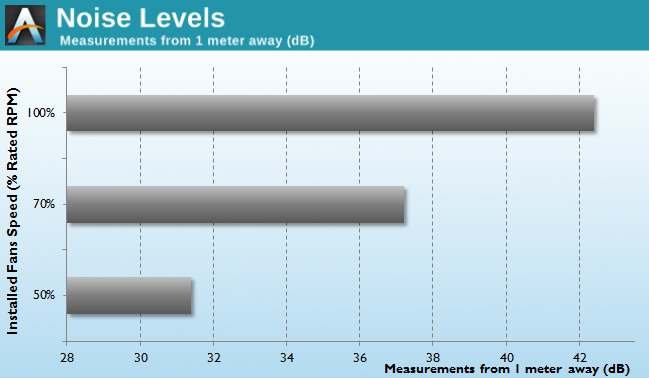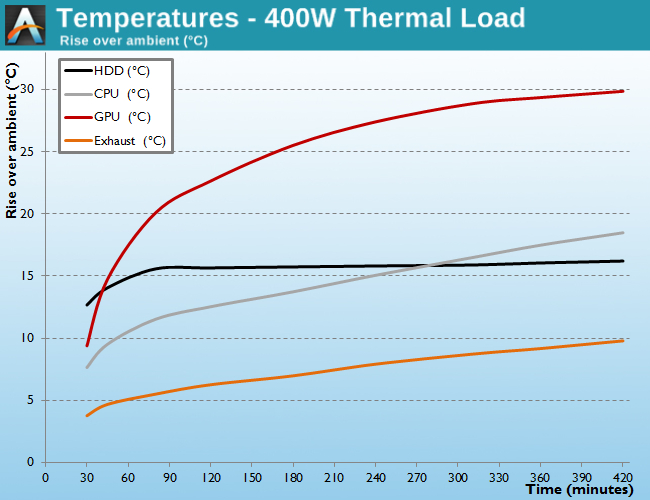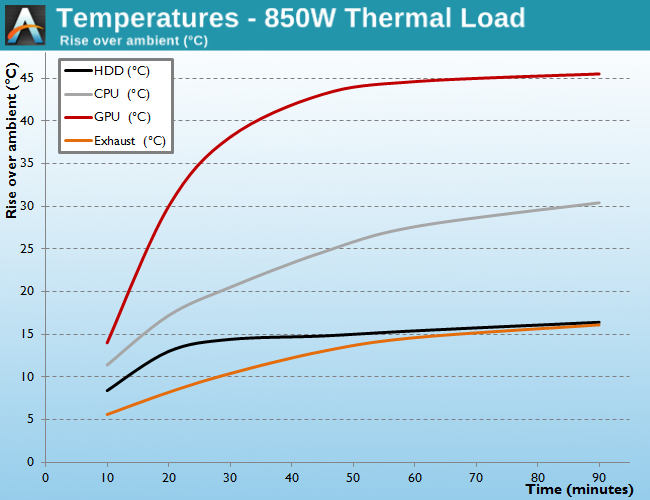Nanoxia Deep Silence 6 Review
by E. Fylladitakis on February 13, 2014 3:00 PM EST- Posted in
- Cases/Cooling/PSUs
- Full-Tower
- HPTX
- Nanoxia
- Case
Test Setup
As noted in our Corsair Obsidian 250D review, we've reworked our computer case testing methodology to improve how systems are tested. This is our first ATX (or larger) case with the new setup so we don't have any comparitive results. Let's quickly go over the basics of our new methodology.
Professional testing requires the simulation of real-world workloads but with repeatable results; this means that a perfectly controllable test setup and environment are required, especially for truly comparable results. Testing the thermal performance of any case with a real-world PC setup technically limits the comparability of the results to that configuration alone, as an active system interacts with its environment and the change of a single component alters many variables.
To accomplish this, we've developed synthetic loads that simulate the thermal output of real systems, with the benefit being that the outputs and loads are passive, steady, and quantifiable. This will allow us to focus on the thermal capabilities of the case alone, as the case has to deal with the entire thermal load by itself, regardless of the system that would be installed inside it.
Laboratory data loggers are used to monitor the PT100 sensors and control the safety relays, which are fully accessible via our custom software. Three such loads have been developed for testing cases: mini-ITX, micro ATX, and standard ATX; we'll use the latter here. The ATX workload simulates a 200W CPU, 50W VRM, 30W RAM and 4 × 120W GFX card thermal load. Finally, three 3.5" HDD dummy loads have also been created, with each of them converting 30W of electrical power to thermal, bringing the total thermal load of the ATX test setup up to 850 Watts.
This is a rather extreme thermal load designed to "separate the men from the boys" as it were, and only the best of cases will be able to handle it for more than a few minutes. We also have a second less extreme workload that consists of a thermal load of 400W, with all of the aforementioned components except the HDD drives at about 42% power, which is more suitable for the majority of cases.
Thermal testing has been performed with all of the case's stock fan operating at maximum speed. Noise testing has been performed with a background noise level of 30.4dB(A).
Results and Discussion
As expected, the thermal performance of the Nanoxia Deep Silence 6 is exceptional. Even with a thermal load of 850W, the temperature readings stabilize relatively quickly, indicating that the stock cooling options of the case can cope with massive thermal loads without the temperatures rising too far above ambient. The space, multitude of ventilation openings, and ample airflow of the stock 140mm fans are sufficient for a continuous thermal load of 850W over 90 minutes.
The temperature of the HDD drives stabilize very quickly and at low temperatures, as the intake fans blow right at our dummy HDD thermal loads. Similarly, the temperature within the GPU area stabilizes quickly, only this time at relatively high temperatures due to the lack of any direct airflow. (Note that blower-style GPUs could help here.) The CPU area meanwhile is caught in the wake of the top and rear exhaust fans, and thus takes the longest time to stabilize but does so with very good final readings.
The temperature of the air exiting the case at the end of our test is at 34.2 °C, 16.1 °C over ambient This is an excellent figure for such a massive thermal load, though this will become more noticeable as we test additional cases; for now you'll have to take our word for it.
Reducing the load down to 400W simply demonstrates the enormous thermal inertia of the gigantic case, which outside of the HDD loads has not stabilized even after several hours of testing. This is part of the reason for using such a large thermal load, as it helps to more quickly distinguish the cooling capabilities of various cases.

The noise levels of the Nanoxia Deep Silence 6 are not as low as we expect from a case with such a name. The five 140mm fans are easily audible from one meter away, with the meter displaying over 42 dB(A). In real-world terms, the Deep Silence 6 is not overly noisy, yet it's clearly audible with all of its fans running at 100%. It's likely that a fair percentage of users might find it overly loud for everyday usage.
After reducing the speed of all installed fans down to 70%, the noise level drops significantly, down to just over 37 dB(A), which equals to a drop of over 50%. After the first speed drop, the case remains audible but comfortable for all but the most sensitive eared users. Finally, halving the speed of all the cooling fans drops the noise levels dramatically, below 32 dB(A), making the Deep Silence 6 very discreet though not yet inaudible in a perfectly quiet environment.
We should note that closing the "chimney", which shuts down the top 140mm fans, has a dramatic impact on the noise levels of the case as well, dropping it down to 32.4 dB(A) with the rest of the fans running at maximum speed. That of course will also reduce the thermal performance of the Deep Silence 6, which may not matter much when you're not running a heavy load on the system, especially considering the size of the case and the remaining ventilation. However, this is not a viable option if a liquid cooling radiator has been installed on the top panel. Obviously reducing the fan speeds will also affect thermal performance, but ultimately the DS6 can cater to either end of the noise/cooling spectrum.












26 Comments
View All Comments
tim851 - Thursday, February 13, 2014 - link
Besides not having any effect on temps, exhausting out the top is bad for noise (in most situations). A case built to be silent should never have top vents.vshah - Thursday, February 13, 2014 - link
One thing missing from the new case review format is pictures of an actual complete install in the case. This was crucial in seeing how cables etc. could be routed with all components in place.E.Fyll - Friday, February 14, 2014 - link
Actually, I skipped such an endeavor thinking that it could be deceiving, as it could appear a lot more messy than it could have become after some care and consideration when routing the cables. On the other hand however, I reconsidered and now think that it would be a good idea to show just how messy things can become. I will plan on adding such info in my future articles.tim851 - Thursday, February 13, 2014 - link
A silent PC was a challenge in 2005 or so. You had to mad, tinker, experiment.Nowadays CPUs and GPUs idle in single watts, good PSUs are semi-passive and half a terabyte of solid state storage are affordable.
Jeffrey Bosboom - Thursday, February 13, 2014 - link
When taking exterior case shots, please include another object so we can get a sense of scale.Sushisamurai - Friday, February 14, 2014 - link
I vote for a coke canredmist77 - Friday, February 14, 2014 - link
Great suggestion!E.Fyll - Friday, February 14, 2014 - link
That sounds like a good idea. Coke can it is, I suppose. Its size is universal. :)Slash3 - Friday, February 14, 2014 - link
Everyone knows that the standard measurement of scale is a banana...http://knowyourmeme.com/memes/banana-for-scale
c4v3man - Thursday, February 13, 2014 - link
I have a Deep Silence 2 case, and while it's a decent case, it's not perfect. On the Deep Silence 2 at least, the air chimney at the top stays open well enough, but I would prefer a reassuring "click" at the top. The hard drive bays (of which there are many) are designed in such a way that they block a lot of airflow... I would prefer a more skeleton-ized design, to let the air move through. And finally, while the doors have a satisfying heft to them, they use a latching system similar to cheap cases today, and of a decade ago. When spending this much of a case, I want the doors to go on with zero hassle. They're not the worst I've ever used, but certainly not the best design.